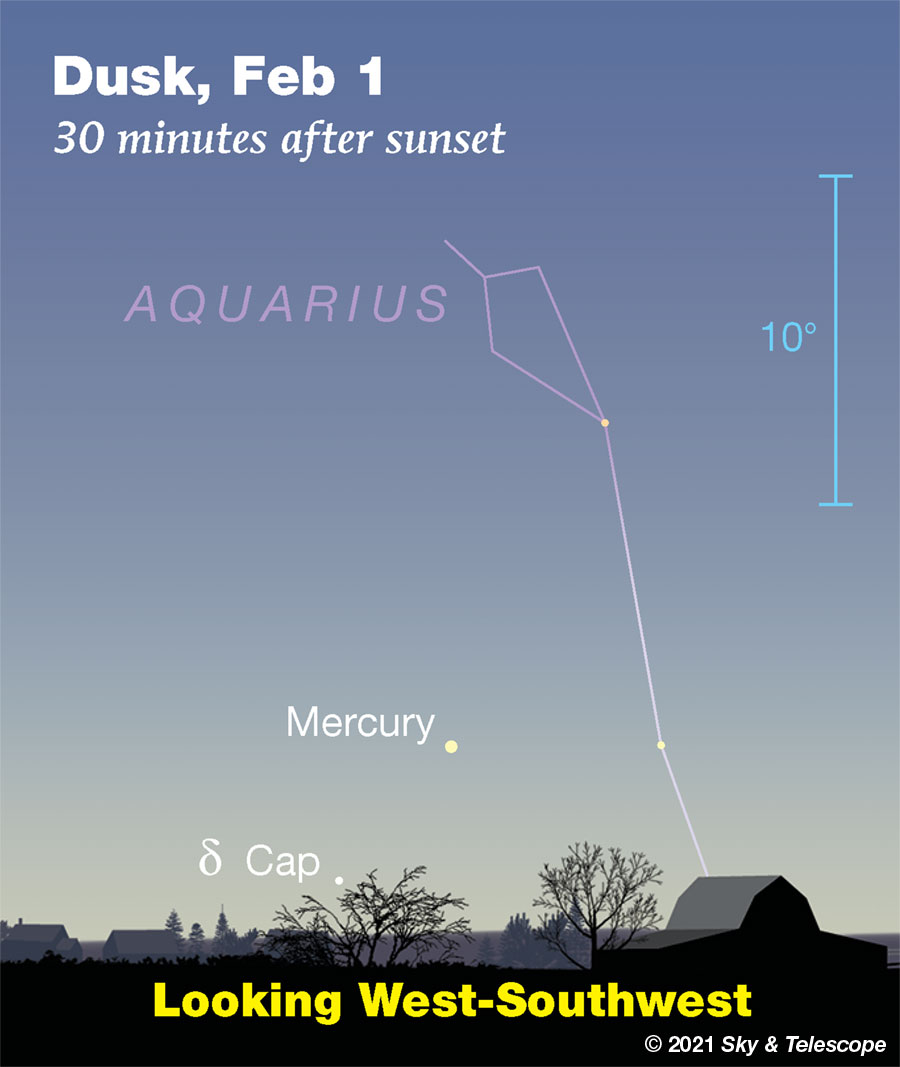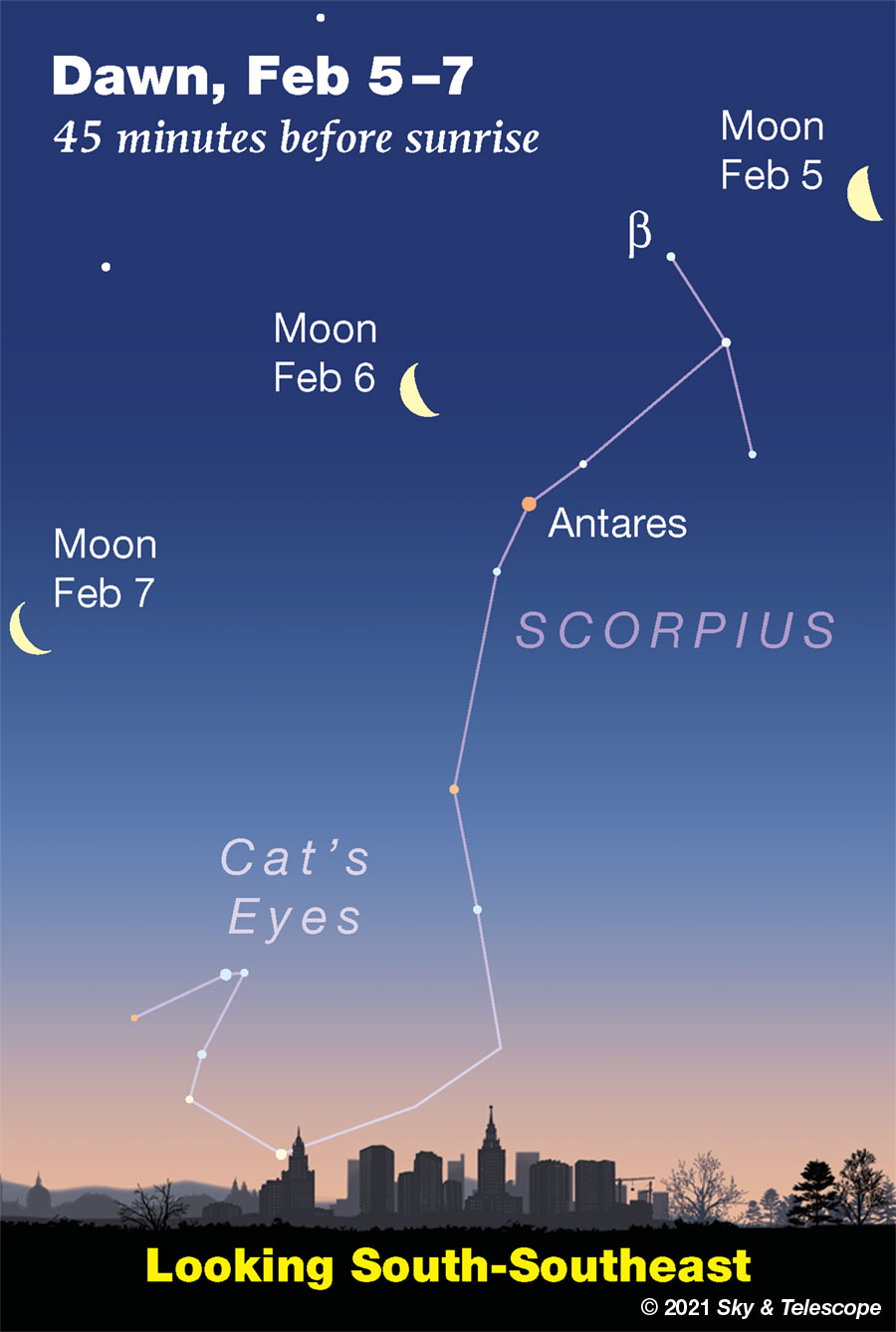FRIDAY, JANUARY 29
■ The Moon, a day past full, rises in late twilight. Once it's well up look for Regulus 4° or 5° to its lower right, and Algieba, slightly fainter, a similar distance to the Moon's left or lower left.
Those are the two brightest stars of the Sickle of Leo. Will the others be lost in the moonlight?
SATURDAY, JANUARY 30
■ Once it's fully dark, spot the equilateral Winter Triangle in the southeast. Sirius is its brightest and lowest star. Betelgeuse stands high above Sirius, by about two fists at arm's length. To the left of their midpoint is Procyon.
Can you discern their colors? Sirius (spectral type A0) is cold white, Betelgeuse (M2) is pale yellow-orange, and Procyon (F5) is paler yellowish white.
SUNDAY, JANUARY 31
■ High in the east this evening, the asteroid 18 Melpomene, magnitude 9.4, creeps along only about 0.1° from 4th-magnitude Alpha Cancri, which itself is less than 2° from the open cluster M67. To identify the asteroid you can use the chart in the February Sky & Telescope, page 49, but that may require close-up work with a magnifying glass and a pencil point. Easier will be a zoomable astro-software chart showing Melpomene's real-time position among fainter stars at a much larger scale.
And about 1° southwest of Melpomene, such a chart should also identify the 10.0-magnitude asteroid 60 Echo. Both are very near opposition tonight.
Hint: Indoors beforehand, review how to use a chart with a telescope (whether a paper chart or on a screen) if you haven't yet mastered the tricks.

MONDAY, FEBRUARY 1
■ Orion is now high in the southeast right after dark. Left of it is Gemini, headed up by Castor and Pollux at far left. The stick-figure Twins are still lying on their sides.
Well below their legs is bright Procyon. Standing 4° above Procyon is 3rd-magnitude Gomeisa, Beta Canis Minoris, the only other easy naked-eye star of Canis Minor. The Little Dog is seen in profile, but only his back. Procyon marks his rump, Beta CMi is the back of his neck, and two fainter stars just above that are the top of his head and his nose. Those last two are only 4th and 5th magnitude, respectively.
TUESDAY, FEBRUARY 2
■ After it’s good and dark, look due east, not too high, for twinkly Regulus. Extending upper left from it is the Sickle of Leo, a backward question mark. "Leo announces spring," goes an old saying. Actually, Leo showing up in the evening announces the cold, clammy, messy back half of winter. Come spring, Leo will already be high.
WEDNESDAY, FEBRUARY 3
■ A favorite field high overhead these nights is the rich Milky Way area at the dragging foot of the Castor stick figure, one of the Gemini twins. Here lie two 3rd-magnitude red giants and the big, filmy, distended speckle of the open star cluster M35, total magnitude about 5. But there's more: the compact cluster NGC 2129 gathered closely around a pair of 7th- and 8th-magnitude stars; the very loose group Collinder 29 with a little Y asterism next to it; and the deep red stars TV and 6 (or V) Geminorum. See Matt Wedel's Binocular Highlight column, "In the Twins' Toes," in the February Sky & Telescope, page 43, with chart. But a scope will do better than binocs.
■ The waning Moon, almost last quarter, rises around 11 p.m. depending on your location. Once it's up, look for Spica about 6° to its right. Nearly 30° to the Moon's left or upper left is brighter Arcturus.
THURSDAY, FEBRUARY 4
■ Last-quarter Moon (exact at 1:47 p.m. EST). Tonight the Moon rises around midnight depending on your location. Find Arcturus about three fists to the Moon's upper left and lesser Spica about half as far to the Moon's upper right.
By early dawn on Friday the 5th the Moon is high in the south, Arcturus is very high over it, and Spica is to its right. Much less far to the Moon' lower left are the head of Scorpius and Antares, as shown below.

FRIDAY, FEBRUARY 5
■ Before and during early dawn Saturday morning the 6th, spot the waning crescent Moon in the south-southeast with Antares some 4° or 5° to its lower right, as shown above.
SATURDAY, FEBRUARY 6
■ The sky's biggest asterism (informal star pattern) — at least the biggest one that's widely recognized — is the Winter Hexagon. It fills the sky toward the east and south these evenings. Start with brilliant Sirius at its bottom. Going clockwise from there, march up through Procyon, Pollux and Castor, then Menkalinan and Capella on high, down to Aldebaran, then to Rigel in Orion's foot, and back to Sirius. Betelgeuse shines inside the Hexagon, well off center.
The Hexagon is somewhat distended. But if you draw a line through its middle from Capella down to Sirius, the Hexagon is fairly symmetric with respect to that axis.
■ Algol should be at its minimum brightness tonight, magnitude 3.4 instead of its usual 2.1, for a couple hours centered 12:46 a.m. EST; 9:46 p.m. PST. Algol takes several additional hours to fade and to rebrighten.
This Week's Planet Roundup
Mercury is dropping down from last week's good apparition in evening twilight, and it's also fading fast. On Friday January 29th Mercury is still almost as high in the south-southwest as it was last week, but at just magnitude +0.5 it may be surprisingly hard to spot if you haven't looked in a few days.
Just three days later on February 1st it's only magnitude +1.5 and dropping faster; see the top image above. Thus ends Mercury's last evening apparition until May.
Venus is hidden deep in the glow of sunrise. Expect it back in the evening twilight come late spring.
Mars (magnitude +0.5, in Aries) shines pale yellow-orange high in the southwest after dark. It sets in the west-northwest around 1 a.m. Mars is only 8 arcseconds wide now and is still as gibbous as it gets, 89% sunlit.
Jupiter and Saturn are out of sight behind the glare of the Sun.
Uranus (magnitude 5.8, in Aries) is several degrees below Mars in early evening. In binoculars Uranus is a little pinpoint "star." But with an apparent diameter of 3.6 arcseconds, it's a tiny, fuzzy ball at high power in even a smallish telescope with sharp optics — during spells of good seeing. Finder chart (without Mars).
Neptune (magnitude 7.9, in Aquarius) is sinking out of sight into the west-southwestern twilight.
All descriptions that relate to your horizon — including the words up, down, right, and left — are written for the world's mid-northern latitudes. Descriptions that also depend on longitude (mainly Moon positions) are for North America.
Eastern Standard Time, EST, is Universal Time minus 5 hours. (Universal Time is also known as UT, UTC, GMT, or Z time. For more see Time and the Amateur Astronomer.)
Want to become a better astronomer? Learn your way around the constellations. They're the key to locating everything fainter and deeper to hunt with binoculars or a telescope.
This is an outdoor nature hobby. For an easy-to-use constellation guide covering the whole evening sky, use the big monthly map in the center of each issue of Sky & Telescope, the essential magazine of astronomy.
Once you get a telescope, to put it to good use you'll need a detailed, large-scale sky atlas (set of charts). The basic standard is the Pocket Sky Atlas (in either the original or Jumbo Edition), which shows stars to magnitude 7.6.

Next up is the larger and deeper Sky Atlas 2000.0, plotting stars to magnitude 8.5; nearly three times as many. The next up, once you know your way around, are the even larger Interstellarum atlas (stars to magnitude 9.5) or Uranometria 2000.0 (stars to magnitude 9.75). And be sure to read how to use sky charts with a telescope.
You'll also want a good deep-sky guidebook, such as Sky Atlas 2000.0 Companion by Strong and Sinnott, or the bigger (and illustrated) Night Sky Observer's Guide by Kepple and Sanner.
Can a computerized telescope replace charts? Not for beginners, I don't think, and not on mounts and tripods that are less than top-quality mechanically, meaning heavy and expensive. And as Terence Dickinson and Alan Dyer say in their Backyard Astronomer's Guide, "A full appreciation of the universe cannot come without developing the skills to find things in the sky and understanding how the sky works. This knowledge comes only by spending time under the stars with star maps in hand."
![]() Audio sky tour. Out under the evening sky with your
Audio sky tour. Out under the evening sky with your
earbuds in place, listen to Kelly Beatty's monthly
podcast tour of the heavens above. It's free.
"The dangers of not thinking clearly are much greater now than ever before. It's not that there's something new in our way of thinking, it's that credulous and confused thinking can be much more lethal in ways it was never before."
— Carl Sagan, 1996
"Facts are stubborn things."
— John Adams, 1770
 0
0









Comments
You must be logged in to post a comment.